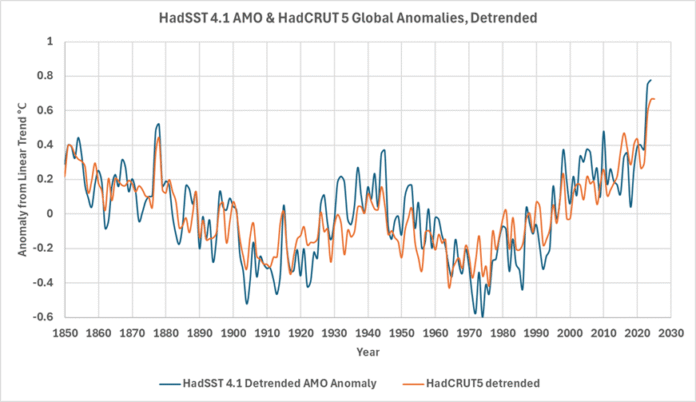By Andy May
We hear a lot about the AMO, or the Atlantic Multidecadal Oscillation. How much does it influence the global mean surface temperature or GMST? Exactly what is the AMO? These are the issues we will discuss. First let’s look at various definitions of the AMO.
Enfield, et al.: “The AMO index [is a] ten-year running mean of detrended Atlantic SSTA [sea surface temperature anomaly] north of the equator.”
Gray, et al.: Uses detrended raw tree-ring measurements to demonstrate a strong and regular 60-100 year variability in basin-wide (0-70°N) North Atlantic sea surface temperatures (SSTs) that has been persistent for the past five centuries.
Trenberth & Shea: “To deal with purely Atlantic variability, it is highly desirable to remove the larger-scale global signal that is associated with global [anthropogenic] processes, and is thus related to global warming in recent decades … Accordingly, the global mean SST has been subtracted to derive a revised AMO index.”
NCAR uses the Trenberth & Shea method, but NOAA uses the original methodology and detrends the North Atlantic temperatures using a least squares linear trend. We will also use the original Enfield and Gray method in this post.
The reason for the AMO SST 60-70-year pattern is unknown, but according to Gray et al. it extends back to 1567AD, so it is a natural oscillation of some kind. Some have speculated that it is a result of the thermohaline circulation in the North Atlantic or a “combination of natural and anthropogenic forcing during the historical era.” (Mann, Steinman, & Miller, 2020). But while interesting these ideas are speculative. Further if the oscillation has existed since 1567, it seems unlikely that it is caused by human CO2 and aerosol emissions.
It is clear that “global” warming is mostly an extra-tropical Northern Hemisphere phenomenon. This is discussed here in figures 1A & 1B and here in the discussion around figure 1, which is also shown as figure 1 below. Regions outside the extratropical Northern Hemisphere don’t change temperature as quickly or as drastically.

A similar pattern can also be seen for the modern era in figure 2.11 in Chapter 2 of AR6 (page 316), part of which is shown as figure 2 below.

Trenberth and Shea’s method of detrending the AMO by first subtracting the global average surface temperature from it is an attempt to remove “global anthropogenic changes” from the AMO signal so it can be viewed as a natural phenomenon. This assumes that global warming has no natural component and is all anthropogenic. However, there is no evidence to support this assumption outside of global climate models. Thus, the Trenberth and Shea version of the AMO index can be discarded if our intent is to show the correlation between GMST and the AMO.
We clearly have a chicken-and-egg problem here. The cause of the AMO pattern is unknown, but does the AMO influence global temperature patterns? Or does some sort of global 60-70-year pattern of warming and cooling affect or cause the AMO?
Figure 3 shows the AMO pattern using HadSST and ERSST sea surface temperatures detrended with linear least-squares best-fit lines. Yearly averages are plotted and the curves are not smoothed.

In figure 3 we see that both the HadSST and the ERSST sea surface temperature records produce the same pattern and closely match each other. This is not surprising since they mostly use the same raw data from ICOADS v. 3 and similar processing methods. Both the 1900-1910 and the early 1970s were colder across the Northern Hemisphere. The spike at the end of both records is probably due to the Hunga-Tonga volcanic eruption in January of 2022.
In figure 4 we plot the detrended HadSST 4.1 record shown in figure 3 with the HadCRUT 5 global surface temperature anomaly detrended in the same way.

Figure 4 is very similar to figure 2 in May & Crok, 2024, but it is extended through 2024 and HadCRUT 4 is replaced by the newer HadCRUT 5. In addition, the detrended HadSST 4.1 AMO region record replaces the NOAA unsmoothed record used in May & Crok.
Figure 4 opens some possibilities. The AMO pattern may influence the global mean temperature anomaly, or the reverse may be true. The former idea is more attractive given the apparent influence that the Northern Hemisphere has on global climate as shown in figures 1 and 2. There is a very close correspondence between the two temperature anomalies and there is very little, if any, time lag between the two, at least in these plots of yearly averages. We can’t be sure which record is driving the other, but they clearly correlate very well.
Figure 2 in May & Crok was criticized because the AMO index plotted did not conform to the Trenberth & Shea definition of the index, that is, the global mean temperature anomaly was not used to detrend the North Atlantic SSTs. But, if we are trying to show the correlation between the AMO and GMST, why would we do that? Even so, figure 3 in Trenberth and Shea shows that the AMO pattern can still be seen after subtracting the GMST, a testament to its strength. Removing the least squares linear trend has “no physical meaning” as Trenberth and Shea write in their paper, but detrending imposes no bias and does not attempt to hide the correlation.
In conclusion, I think it is very clear from the data presented in this post that Northern Hemispheric climatic changes drive global changes as shown in figures 1 and 2. It is also clear that the AMO and global average surface temperature patterns are closely related, with the AMO being the stronger pattern of the two. Gray, et al. show that the AMO 60-70-year AMO pattern extends into the past at least to 1567AD, which argues against any anthropogenic cause for the AMO or GMST patterns.
Enfield, D., Mestas-Nunez, A. M., & Trimble, P. (2001). The Atlantic multidecadal oscillation and its relation to rainfall and river flows in the continental U.S. Geophysical Research Letters, 28(10). Retrieved from https://agupubs.onlinelibrary.wiley.com/doi/pdfdirect/10.1029/2000GL012745
Gray, S. T., Graumlich, L. J., Betancourt, J. L., & Pederson, G. T. (2004). A tree-ring based reconstruction of the Atlantic Multidecadal Oscillation since 1567 A.D. Geophys. Res. Lett., 31. doi:10.1029/2004GL019932
Mann, M., Steinman, B., & Miller, S. (2020). Absence of internal multidecadal and interdecadal oscillations in climate model simulations. Nat Commun, 11. doi:10.1038/s41467-019-13823-w
May, A., & Crok, M. (2024, May 29). Carbon dioxide and a warming climate are not problems. American Journal of Economics and Sociology, 1-15. doi:10.1111/ajes.12579
Trenberth, K., & Shea, D. (2006). Atlantic hurricanes and natural variability in 2005. Geophysical Research Letters, 33. Retrieved from https://agupubs.onlinelibrary.wiley.com/doi/pdf/10.1029/2006GL026894
Related
Discover more from Watts Up With That?
Subscribe to get the latest posts sent to your email.



